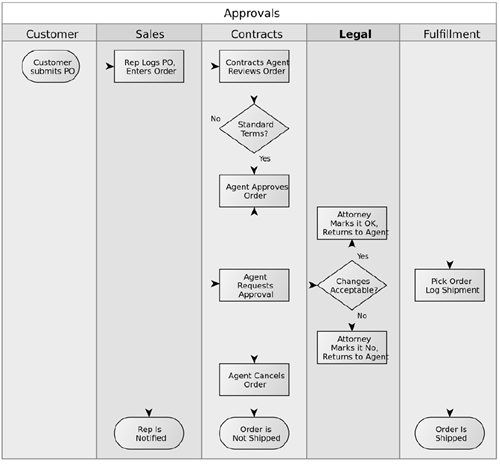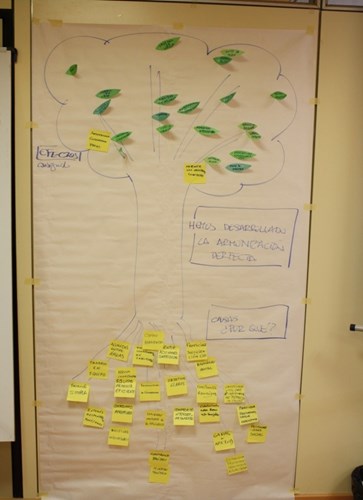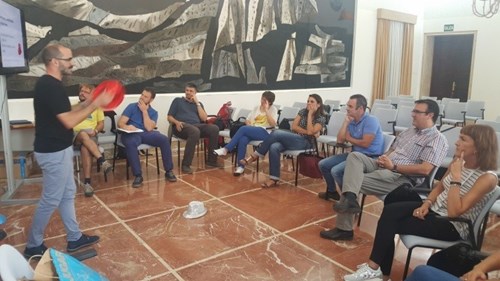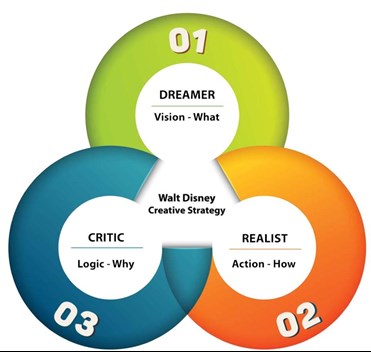Tools to be used in step 2.2.1 "Initial Assessment"
Process mapping
The goal of the process mapping activity is to:
- Show the actors (administration, external experts, stakeholders, coordinator)
- Show the activities (useful, targeted, unproductive)
- Show the inputs and outputs (data input, report)
for the relevant processes which lead to a SEAP/ SECAP and SUMP.
For the evaluation of the quality of the processes the following criteria can be used:
- Effect on tangible results
- Effect on actual implementation
- Value added from stakeholders´ point of view
- Effect on stakeholders´ satisfaction
- Time spent
- Resources spent
- Transparency of actors' roles
Practical tip: Mapping the processes how plans are developed today:
A simple yet very effective tool that can be used to facilitate the discussion is to map the processes of SEAP/SECAP and SUMP development using post-it notes. The facilitator sticks several large white sheets of paper (for example flipchart paper) on the wall. On these, one can then draw a number of swim lanes.
The workshop participants write the individual process steps on post-its (one process step per post-it). The team then maps the existing process using the post-it notes in the swim lanes and subsequently discusses improvement opportunities. Placing the post-its from left to right reflects the sequence of the activities. However, do not include arrows or other links directly on the white paper since - when you change the order of the post-its - these markings will be confusing.
A good aspect of the post-it notes is that one can easily move the process steps from one swim lane (Figure 4) to another or alternatively eliminate a step by taking the post-it off the paper. Lastly, the post-it map is easily translated into a mapping software (such as Lucidchart or MS Visio) since the same logic and tools are used. Figure 3 shows a process map composed of the description of individual steps on post-its.

Figure 4: Example of a swim lane diagram (http://commons.wikimedia.org/wiki/File:Approvals.jpg)
When conducting process analyses, it is important to stay focused on the goal, i.e. improving the processes, making them more efficient and effective. The result of the process needs to be in the spotlight: what is it that we want to achieve or obtain in order to satisfy the client of the process? Keeping the following approaches in the back of your mind during the exercise will help you and your team stay on track and might trigger thinking out of the box:
RETHINK
Why do it this way? Is there a different way to reach the objective? Is there a better, faster, cheaper way to complete the steps?
RECONFIGURE
Can we consolidate common activities? Can we eliminate non-value adding work? How can sharing information improve the process?
REASSIGN
Can activities be moved to different departments with better access to relevant information or to stakeholders or people with more experience on the task? Can the activity be outsourced?
RE-SEQUENCE
Can the number of interconnections and mutual dependencies be reduced?
RELOCATE
Can an activity be attached to related activities?
RETOOL
Can mutual training improve the process? Can a data bank support the process? Can coordination meetings support an easy process flow?
REDUCE
How can critical resources be used more effectively? Can a stable planning process be designed with less need for detailed data? Would more information enable greater effectiveness?
Problem tree analyses - in a positive way
The “problem, objective and strategy tree” analysis is a participatory tool of mapping out main problems, along with their causes and effects. In Spain, a harmonization team used the problem tree in a different way: during a workshop a problem tree was developed by highlighting the positive aspects which result from harmonization as compared to the present situation of the status of separate SEAPs and SUMPs. The “leaves” show the effects or impacts. The “roots” of the tree show the causes leading to a “perfect” harmonization of SEAP and SUMP.
Representatives of the different municipalities participated in the activity, determining causes and effects according to their criteria and experience.
The activity provides guidance for the way forward to a future harmonization, highlighting the good practices and actions followed.

Figure 5: Result of a problem tree analysis from Spain
The six thinking hats, by Edward De Bono
The most important elements of this method are six hats with different colours. Each colour corresponds to a character or personality. When wearing the different hats, the participants shall contribute different points of view to a problem.
The characters of the hats are:
1. White hat: Think in an objective and neutral way.
2. Red hat: Express the feelings, without need for justification.
3. Yellow hat: Look only at the positive aspects on a certain aspect.
4. Black hat: Be critical in a negative way; identify why something will not go well.
5. Green hat: Apply creative and lateral or divergent thinking.
6. Blue hat: To control the rest of the hats; control the time, the order of events and collect the contributions of the participants.

Figure 6: Application of the six hats in a workshop in Spain
Please note: A moderator of a workshop needs to have effective listening skills to guide the group. The moderator needs to be flexible to follow the participant’s thoughts and feelings. Furthermore he/she should have a topical expertise to guide the discussion. The moderator needs the ability to understand language used by participants and to interpret the statements so that they always relate to the topic.
Expected outputs:
- Document: initial assessment of available data opportunities for the improvement of the SEAP/SECAP and sump processes.
Tools to be used in step 2.2.1 "Involvement of partners and stakeholders"
There are many different techniques designed to reach and enhance stakeholders’ engagement, including public consultations, questionnaires, surveys, social media contributions, workshops, open debates, mass communication, participatory activities in the city, etc. (see Table 2).
Again, every technique must be adapted and designed bearing in mind which stakeholder is targeted, as well as the input we want to get through the activity.
We recommend to contact the previous teams involved in developing the existing SEAP/SECAP and SUMP (if applicable) and gather as much information as possible, contact and solicit feedback from additional relevant stakeholders, and, if possible, try to assess through surveys the current public opinion and expectations to avoid missing important information and points of view.
Civil Jury
“Civil jury” includes a number of citizens and enables the formulation of recommendations on a specific activity or a problem that needs to be solved.
Basically, the civil jury follows the model of a jury in which randomly selected citizens without special backgrounds discuss the reported evidence and come to a decision or recommendation. The debates are carried out on a predefined set of questions and are facilitated by a moderator who does not intervene in the discussion. Citizens may listen to experts who offer different perspectives. The civil jury listens to the reported evidence by the experts and has the right to ask questions for further clarification. Based on the information the jury proposes recommendations for concrete measures. Outcomes and solutions are presented in a Citizen’s Report which is delivered to officials. Often the choice of experts and the range of questions that will be put forward to discussion are determined by an Advisory Board.
Visual Planning
Visual planning is a method which is often applied in the urban planning process. It is a structured community-oriented process aiming at mobilizing the citizens’ active involvement in the development and improvement of the urban environment. The participants in the visual planning process identify problems and barriers in the community they live in, develop ideas for improvements, to access currently not used but available funding resources.
Initially community representatives are gathered and construct a 3D model of the respective city/district/ quarter, which is located at different open spaces and visible places. After that the available resources and human capacities and skills are defined and a discussion is organized to debate and trigger possible interventions. Subsequently the participants divided into working groups set priorities and develop action plans.
Example: Self-assessment to identify strengths and weaknesses. Koprivnica. Croatia
The city of Koprivnica, Croatia, undertook a project to promote walking and cycling and to better incorporate them into the existing transport
system. At the very beginning of the Active Access project (www.active-access.eu), a detailed status-analysis was carried out. This was based on a self-assessment carried out by the municipality itself, an extensive consultation process with a range of stakeholders, and a public survey. The public survey was conducted among citizens who use active forms of mobility Iwalking, bicycling), as well as those who primarily use their private cars. A solid self-assessment was crucial in choosing the right focus for Koprivnica’s mobility planning, and assured great public acceptance during the implementation phase.
Example: Stakeholder involvement process from Austria
During the definition of the MOMAK (Mobility Concept for the Federal State of Carinthia) more than 40 stakeholder meetings were conducted on the level of the individual district. This process created awareness, contributed to the collection of various solutions and prepared the implementation of the measures very well.
The 20 invited technical experts analyzing data and developing solutions met in four additional workshops.
Source and further information are available on:
www.eltis.org/discover/case-studies/self-as-sessment-identify-strengths-and-weaknesses-koprivnica-croatia
Moderation methods for Stakeholder meetings
Walt Disney method
The Walt Disney method is a creativity strategy in which a group uses three specific thinking styles in turn. It involves parallel thinking to analyse a problem, generate ideas, evaluate ideas, construct and criticize a plan of action.
In order to prepare the team for Walt Disney’s creative strategy, three parts of the room are set for each thinking method. The first part is for dreaming and imagination, the second part is for realists and/or planning and the third part is for critics.
The team gathers with a target to achieve, this target can be a dream to turn into reality, a design to visualize, a problem to solve or a process to improve.
The approach is based on deviding the creative process into three main stages each using a different approach; the dreamer, the realist and the critic. Each stage represents a style of thinking and should be applied in the same sequence:
The dreamer
Any creative idea usually starts with a visionary anticipation, full of passion and enthusiasm. In ordinary meetings, this dreaming style is blocked by premature criticism and does not have the space to go further on. The first stage allows the team to share their dream without restrictions or criticism. This supports imagination and free flow of associations to generate creative ideas. Some of these ideas are feasible and others are probably not.
Separating the feasible concepts comes later as a result of the second and third stages in the approach. The dreamer asks questions that help describing ideas and thoughts such as the following:
What do we want? What is the solution? How do we imagine the solution? What are the benefits of applying this solution?
The realist
Subsequently, the realist stage follows. The team physically shifts the location (e. g. to another room) and thinking mode to think in a more logical rational style. Based on the first stage, the attendees pretend that the dream can be implemented and start making plans to achieve it. The plans aim to turn the imaginary ideas into a manageable action plan. During this stage all the thoughts should be constructive and targeted turning the idea into a real plan. This stage includes questions such as the following:
How can we apply this idea in reality? What is the action plan to apply the idea? What is the timeline to apply this idea? How to evaluate the idea?
The critic
As a third stage, the critic thinking mode shall discover the barriers of applying the idea and how to overcome them. In this session, the team provides a constructive evaluation for the idea in order to find the weak points and solve it in the final solution. In this stage, the team asks questions as following:
What could be wrong with the idea? What is missing? Why can’t we apply it? What are the weaknesses in the plan?n?

Figure 7: The Walt Disney method
Conclusion
As a result of the three stages of the Disney’s Creative Strategy, the team reaches a solid creative idea with an action plan to apply it.
The first stage is focused on the creative aspect and sharing creative ideas and solutions.
The second stage is focused on a reality check and how to turn the idea into an action plan and finally the third stage is aimed at identifying the weakness in the idea and overcoming barriers and shortcomings it in the final plan.
World Café
The World Café is a group interaction method focused on collecting ideas from bigger groups by providing a framework for associations and combinations of ideas. A World Café conference is a creative process to support collaborative dialogue, share knowledge and spark ideas in groups. The meeting room is set up like a café, with about four tables covered with paper. The groups are supplied with refreshments. A group of four to eight participants sits at a table and holds a discussion lasting from 20 to 45 minutes about one or more predefined questions. The resulting ideas are noted on the paper. At the end of each round, one person remains at each table as the host, while the others continue to other tables. The table hosts welcome newcomers to their tables and share the essence of that table’s previous conversation as a starting point for the next discussions. The new participants at one table take up the ideas noted on the paper table cloth and then the conversation continues, deepening as the rounds progress.
World Cafe events should be designed and hosted according to the following principles:
- Clarify the context
- Create a hospitable environment
- Explore questions that matter
- Encourage everyone’s contribution
- Connect diverse perspectives
- Listen together for insights and deeper questions
- Gather and share collective discoveries
Further information on how to host a World Cafe is provided in “A Quick Reference Guide for Hosting World Café”, 2015 The World Café Community Foundation.
Kahoot
Kahoot is a free response tool for administering quizzes, facilitating discussions, or collecting survey data. Questions are projected on a shared screen, while an unlimited number of players answer the questions with their smartphone, tablet or computer. This creates a social, fun and game-like environment. Kahoot allows for the design of multiple-choice quizzes as well as polls and surveys facilitating on the spot data collection; the quiz questions and polls stimulate quick instructional decisions as well as whole-class discussion.
Practical experience from a workshop in Spain: the Kahoot tool was quite useful to generate debate among the participants and this resulted in a better understanding of their needs and points of view. For this reason, the objective of the dynamics is not to compete but to promote discussion by playing with options, answers and scores.

